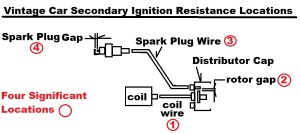Secondary Ignition Physical Part 2 restoration article is inspired by the upcoming May 2019 “Tech Event” being hosted by the Nichols at their home.
Part 1 covered the need for having ignition data on your unique vintage car, getting a routine “physical” to collect present data, & finally delved into some secondary ignition resistances:
Part 2 will review the importance of inspecting Secondary voltages & causes. Why spend the time doing this? Excessive Secondary voltages can lead to component premature breakdowns such as the coil itself, ECU if present, Distributor Cap/Rotor/Point terminals, & Spark Plugs.
Compare a running brook or creek water depth to Secondary voltages. At the head of the creek the water has a given depth that is controlled by many items with resistance to flow of the water being a big contributor. The Secondary voltage is similar with downstream resistances such as combined effects of secondary wire resistances, gaps between distributor rotor & cap terminals, & spark plug gaps. In the analogy between a creek & secondary voltage the creek has length, debris along the way, creek width, & man made structures such as dams contributing to the water depth. If suddenly a beaver family moves in & builds another restriction, water level will rise. Secondary voltage rises as secondary resistances increase.
Rising Secondary Voltage can lead to sooner ignition component failures/hard starting.
Monitoring coil/spark plug wire voltage can help detect undesired resistances developing in the secondary ignition circuit. The Sun Tester can not only give the coil/spark plug wire Secondary voltage but it can also superimpose each wire Secondary voltage for comparison:
http://www.plymouthcarclub.com/2016/12/measuring-ignition-health/
Other type testers can give the “spark output” or Secondary voltage for a particular wire while the Sun Tester adds additional detail on the Secondary voltage helping to pinpoint the cause.
Vector files for the above:

